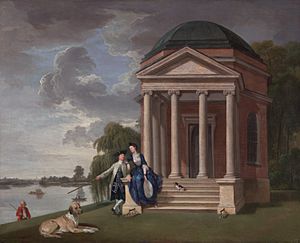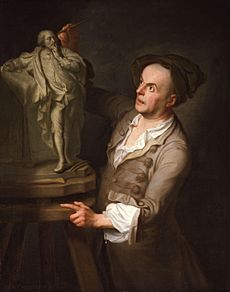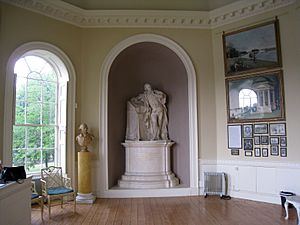Garrick's Temple to Shakespeare facts for kids

David Garrick and his Wife by his Temple to Shakespeare at Hampton,
Johan Zoffany, c. 1762 |
|
| Coordinates | 51°24′45″N 0°21′34″W / 51.4124°N 0.3594°W |
|---|---|
| Location | Hampton, London |
| Type | Folly |
| Material | Brick |
| Beginning date | 1755 |
| Completion date | 1756 |
| Dedicated to | William Shakespeare |
| Designations | |
|---|---|
|
Listed Building – Grade I
|
|
| Official name | Garrick's Shakespeare Temple |
| Designated | 2 September 1952 |
| Reference no. | 1065456 |
Garrick's Temple to Shakespeare is a special little building called a garden folly. It was built way back in 1756. You can find it on the north side of the River Thames in Hampton, which is part of London.
This temple is a very important historical building, given a "Grade I listed" status. A famous actor named David Garrick built it. He wanted to honor the amazing playwright William Shakespeare, whose plays Garrick performed often.
When Garrick was alive, he kept his collection of Shakespeare's things inside the temple. He also used it to entertain his family and friends. Over the years, many different people owned the temple. In the 1930s, it became public property.
By the end of the 1900s, the temple was in bad shape. But thanks to a big effort from famous actors and money from the National Lottery, it was fixed up in the late 1990s. Today, it's open to the public as a museum. It celebrates David Garrick's life and his love for Shakespeare. Some people say it's the only place in the world built just to honor Shakespeare!
Contents
What the Temple Looks Like
The temple is shaped like an octagon, which means it has eight sides. It has a rounded roof, like a dome, similar to the ancient Pantheon building. It's made of plain brick.
The main entrance faces east. It has a fancy front porch, called an Ionic portico, with four columns across and three columns deep. You walk up several steps to reach this entrance.
Inside, there are tall, arched windows that reach almost to the floor. These windows face the river, giving a beautiful view. On the back wall, there's a deep curved space where a statue used to stand. Outside, there's a lovely lawn and garden. From here, you can enjoy views of the Thames River.
History of the Temple
How it Was Built
David Garrick built the temple on land next to his country home, Garrick's Villa. He bought the villa in 1754 as a quiet place to relax. The garden by the river, now called Garrick's Lawn, was separated from his main house by a road.
To get to the garden privately, Garrick had a special tunnel built under the road. It was quite fancy, lit up by 500 lanterns!
Around 1755, Garrick decided to build a summer-house by the river. He wanted it to be a "temple" dedicated to Shakespeare, his inspiration. We don't know for sure who designed the temple. Some people think it might have been Robert Adam or Lancelot "Capability" Brown. There's a similar "Ionic Temple" at Chiswick House nearby. Garrick had stayed at Chiswick House for his honeymoon, so it might have given him the idea.
His friend Horace Walpole wrote about the temple in 1755. He said Garrick was building a "graceful temple to Shakespeare." Walpole even suggested a Latin motto for it, which means: "If I inspire and give pleasure, it is because of you."
The garden in front of the temple was designed in a special way. It followed ideas from Garrick's friend, the artist William Hogarth. There was an S-shaped path winding through flowering bushes. This design was popular because it looked natural and beautiful. Walpole even gave Garrick some Italian cypress trees for the garden.
The garden was so lovely that another friend, Samuel Johnson, once told Garrick: "Ah, David, it is the leaving of such places that makes a deathbed so terrible."
What Was Inside

The inside of the temple was like a special shrine to Shakespeare. The most important item was a statue of the playwright. Garrick asked a French sculptor named Louis-François Roubiliac to create it. It cost a lot of money back then!
Roubiliac based the statue on a famous painting of Shakespeare. It's even said that Garrick himself posed for the statue. Because of this, the statue looks a bit like Garrick! He supposedly struck a pose and said, "Look, the Bard of Avon!" to show how he wanted Shakespeare to appear. Garrick wasn't happy with the first head Roubiliac carved, so it had to be replaced.
During Garrick's life, the statue was displayed in the temple. After he died, he left it to the British Museum. It was later moved to the British Library. Today, a copy of the statue, given by the museum, is displayed in the temple.
Garrick also showed off his collection of Shakespeare's belongings in the temple. One special item was a chair made from a mulberry tree. People believed this tree was planted by Shakespeare himself at his home in Stratford upon Avon. The chair was designed by Hogarth and had a medal of Shakespeare carved into its back. This chair still exists and is now in the Folger Shakespeare Library in Washington, D.C.
Other items included Shakespeare's old leather glove, a dagger, and a ring with "W.S." on it. After Garrick's wife died, his huge collection of Shakespeare items was sold. It took ten days to auction everything!
How the Temple Was Used
Garrick used the temple for more than just a museum. It was a working building too. He used it as a quiet place to learn his lines for plays and write letters. He also entertained his wife and guests there for afternoon tea and dinner.
The painter Johann Zoffany, who Garrick helped, painted many scenes of Garrick, his wife, and their friends on the lawn and in front of the temple. One guest, Mrs. Delany, described a party in 1770:
We had an excellent dinner nicely served, and then went over directly into the garden – a piece of irregular ground sloping down to the Thames, very well laid out, and planted for shade and shelter; and an opening to the river which appears beautiful from that spot, and from Shakespeare's Temple at the end of the Improvement, where we drank tea, and where there is a very fine statue of Shakespeare in white marble, and a great chair with a large carved frame, that was Shakespeare's own chair, made for him on some particular occasion, with a medallion fixed in the back. Many were the relics we saw of the favourite poet. At six o'clock Lady Weymouth's fine group of children walked into the garden, which added to the agreeableness of the scene.
Visitors were encouraged to write poems honoring Shakespeare and leave them at the statue's feet. Garrick even had the best ones published in London newspapers. Some people, like Samuel Foote, joked that Garrick was honoring himself as much as Shakespeare. Even Voltaire, a famous French writer, made fun of the temple in a letter. Some people thought Garrick was trying to make himself as famous as Shakespeare.
In August 1774, the temple and gardens were the main attraction for Garrick's 25th wedding anniversary party. The London Chronicle newspaper reported:
Last night Mr Garrick gave a splendid entertainment or Fete Champetre at his gardens at Hampton. Signior Torre conducted a most brilliant fire-work; an elegant concert of music was performed; and the company, which consisted of a great number of Nobility and Gentry, expressed the utmost satisfaction on the occasion. The temple of Shakespeare, and gardens, were illuminated with 6000 lamps, and the forge of Vulcan made a splendid appearance.
Garrick also opened the temple and garden to the public sometimes. Every May Day, he and his wife would sit on the special chair. They would give money and cakes to the poor children of Hampton. One woman remembered: "When I was called up, I took my six [children] into the Temple, where Mr Garrick was sitting by the fine bust with great cakes before him; he took down all their names, and then gave a shilling and a piece of plum-cake to every individual one; not even leaving out poor babes in their mothers' arms."
Keeping and Fixing the Temple
Garrick's wife kept the temple and villa until she died in 1822. After that, her lawyer, Thomas Carr, bought it. He made sure to keep it as a tribute to Garrick. He even put a statue of Garrick in the temple to replace the Shakespeare one.
The property changed hands several times. In 1923, the villa was turned into apartments. The riverside garden and temple were sold separately. A man named Paul Glaize bought them and built a three-story house right next to the temple. This caused a huge public outcry!
Because of the protests, the Hampton Urban District Council bought the site in 1932. Glaize's house was torn down. The lawn and temple were then opened to the public. They have been public property ever since.
During World War II, the temple was used by Air Raid Precautions wardens. In 1952, it was given its Grade I listed status. By the 1970s, however, it had been neglected and damaged by vandals. It suffered from rot, and traffic vibrations from the nearby road caused damage. Thieves even stole the lead from the roof.
A special architectural firm, Donald Insall Associates, was hired to restore the building. The work cost £37,000.
By the 1990s, the temple was in bad shape again and had been badly vandalized. A local newspaper reported in 1994 that it was "dangerously broken" and had graffiti on its walls. Vandals had also chopped away one of the wooden columns.
In 1995, a campaign started to fix up the temple and garden. The Heritage Lottery Fund gave £70,000 in 1998–99. Other local groups and a campaign led by actor Clive Francis helped raise more money. Famous actors like Sir John Gielgud, Dame Judi Dench, and Jeremy Irons also donated.
Donald Insall Associates did the restoration work again. The temple reopened to the public in late 1998. In early 1999, the garden was replanted to look like it did in Garrick's time. The British Museum provided a copy of Roubiliac's Shakespeare statue to put back in its original spot. The temple now has an exhibition about Garrick's life and career. The project was finished by April 1999.
Today, Garrick's Temple is managed by a group called Garrick's Temple Partnership. It includes the local council and several trusts. The actor Clive Francis leads the Garrick's Temple to Shakespeare Trust. The temple is open to the public on Sunday afternoons from April to September. It's also used for concerts, meetings, and private events. It even has educational programs for local schoolchildren.
See also
- Astoria (recording studio) (a neighbor)
- Shakespeare's signet ring, a ring that might have belonged to William Shakespeare. Like the ring in Garrick's Temple, it also has the letters WS





